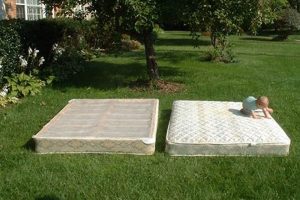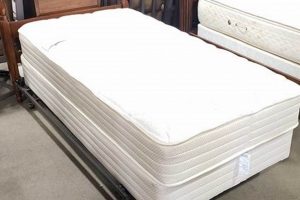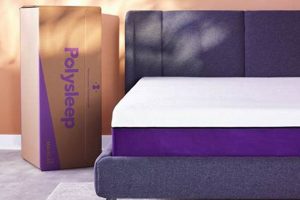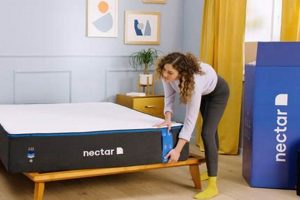This type of bed represents a modern approach to purchasing and receiving bedding. It involves compressing, wrapping, and delivering a mattress directly to a consumer’s doorstep, typically in a manageable cardboard container. As an example, a memory foam or hybrid mattress, designed for standard bed frames, can be efficiently compacted and shipped in this manner.
Its significance lies in its convenience and cost-effectiveness. The elimination of traditional retail markups, coupled with simplified logistics, often translates to lower prices for consumers. Furthermore, the ease of delivery and setup has revolutionized the mattress industry, providing a more accessible option. Historically, buying a mattress involved visiting physical stores and arranging for bulky delivery, but this new model streamlines the entire process.
Having defined this category of product, the following discussion will explore various aspects such as the types of materials commonly used, the compression and unboxing processes, considerations for choosing the right one, and their environmental impact.
Selecting an Appropriate Bed-in-a-Box
The following guidance is intended to assist in making informed decisions when purchasing mattresses delivered in compressed packaging. Understanding specific needs and preferences is paramount.
Tip 1: Research Material Composition: Prioritize investigation into the materials used. Memory foam, latex, and hybrid models offer distinct support and comfort levels. Consider density and certification for safety and durability.
Tip 2: Assess Firmness Requirements: Firmness is subjective; however, consider body weight, sleeping position, and any existing back or joint conditions. Reviews and manufacturer specifications provide guidance.
Tip 3: Evaluate Edge Support: For individuals sharing a bed or requiring assistance getting in and out, edge support is crucial. Check for reinforced edges in product descriptions and customer feedback.
Tip 4: Investigate Temperature Regulation: Certain materials retain heat more than others. If overheating is a concern, explore options with cooling gel infusions, breathable fabrics, or open-cell foam construction.
Tip 5: Review Trial Periods and Return Policies: Reputable brands typically offer trial periods, allowing consumers to test the product at home. Thoroughly understand the return policy, including any associated fees or requirements.
Tip 6: Compare Warranty Coverage: Mattress warranties vary significantly. A comprehensive warranty protects against defects in materials and workmanship, providing long-term value and peace of mind.
Tip 7: Check for Certifications: Look for certifications such as CertiPUR-US, OEKO-TEX, or GOLS. These indicate that the product has been tested for harmful substances and meets specific environmental or safety standards.
Adhering to these recommendations can lead to a more satisfactory purchase, ensuring comfort, support, and longevity.
The subsequent section will delve into the unpacking and setup procedures, addressing potential challenges and best practices.
1. Compression Technology
Compression technology is integral to the bed-in-a-box concept, facilitating efficient packaging and transport. Its application represents a significant departure from traditional mattress distribution methods, fundamentally altering supply chain dynamics.
- Volumetric Reduction
This process reduces the mattress’s original volume, enabling it to fit into a comparatively small container. For instance, a queen-size mattress can be compressed to a size suitable for single-person handling, drastically decreasing shipping costs and logistical complexity.
- Material Science Applications
Material science plays a crucial role in the compression process. Foams, such as memory foam and latex, are selected for their ability to withstand compression and subsequently recover their shape without significant degradation. Hybrid models require careful consideration to ensure coil integrity post-compression.
- Packaging Integrity
Effective packaging maintains compression during transit. Durable, multi-layered plastic films are used to encase the compressed mattress, preventing expansion and protecting against environmental factors such as moisture and pests. Vacuum sealing is often employed to maximize compression.
- Re-expansion Dynamics
Upon unboxing, mattresses re-expand to their original dimensions. Factors such as ambient temperature and time elapsed since compression influence the rate and completeness of re-expansion. Manufacturers typically provide guidelines for optimal unboxing conditions to ensure full recovery of the mattress’s intended shape and support characteristics.
The convergence of volumetric reduction, material science, packaging integrity, and controlled re-expansion enables the practical realization of delivering mattresses in a box. The integration of these elements ensures the feasibility and effectiveness of this distribution model.
2. Direct-to-Consumer
The direct-to-consumer (DTC) model is a cornerstone of the bed-in-a-box phenomenon. This distribution strategy eliminates intermediaries, such as brick-and-mortar retailers, thereby establishing a direct relationship between manufacturer and customer. This shift has several consequences: reduced overhead costs, greater pricing transparency, and increased control over brand messaging and customer experience. A prime example is the emergence of online mattress companies that exclusively sell their products through their own websites, bypassing traditional retail channels entirely.
The significance of DTC within the bed-in-a-box context extends beyond mere cost savings. It allows manufacturers to collect direct customer feedback, enabling continuous product improvement and customized service offerings. This also fosters brand loyalty through personalized marketing and responsive customer support. Furthermore, the DTC model provides greater flexibility in product innovation and experimentation, as manufacturers are not constrained by the demands or limitations of retail partners. For example, bed-in-a-box companies often offer extended trial periods and hassle-free return policies, features that would be more challenging to implement through traditional retail channels.
In summary, the DTC model has revolutionized the mattress industry by enabling streamlined operations, enhanced customer engagement, and greater agility in product development and marketing. While challenges such as managing logistics and building brand awareness remain, the benefits of DTC are substantial, contributing significantly to the widespread adoption and ongoing success of the bed-in-a-box market.
3. Variety of Materials
The diverse array of materials employed in mattresses significantly impacts comfort, support, durability, and overall user experience. Within the realm of mattresses delivered in compressed packaging, the selection of suitable materials becomes even more critical due to the constraints imposed by compression and subsequent re-expansion. This necessitates careful consideration of material properties and their behavior under stress.
- Memory Foam
Memory foam, characterized by its viscoelastic properties, conforms to the body’s contours, providing pressure relief and motion isolation. In the context of mattresses delivered in compressed packaging, high-density memory foam is frequently utilized due to its ability to recover its original shape after compression. However, its tendency to retain heat can be a drawback, addressed through gel infusions or open-cell structures.
- Latex Foam
Latex foam, derived from either natural rubber or synthetic sources, offers a resilient and supportive sleep surface. Natural latex, in particular, is prized for its breathability and durability. Mattresses delivered in compressed packaging often incorporate latex layers to provide a responsive feel and enhance airflow. Its inherent elasticity contributes to its ability to withstand compression without permanent deformation.
- Innerspring Coils
Innerspring coils provide foundational support and contribute to airflow within the mattress. Hybrid mattresses delivered in compressed packaging often utilize individually wrapped or pocketed coils to minimize motion transfer and enhance contouring. The gauge and configuration of the coils directly influence the firmness and support characteristics of the mattress. The ability to compress and rebound is key for use in this sector.
- Hybrid Constructions
Hybrid mattresses combine the properties of different materials, such as memory foam, latex, and innerspring coils, to achieve a balanced combination of comfort and support. These designs offer the potential to address specific sleep needs and preferences. Due to the complex interaction between these materials, compression requires careful engineering to ensure uniform recovery and prevent localized deformation.
The integration of these various materials into mattresses highlights the sophistication of modern bedding technology. Material selection is inextricably linked to the design, performance, and lifespan of a compressed and delivered mattress, directly influencing consumer satisfaction. Further advances in material science are likely to yield even greater customization and optimization possibilities.
4. Unboxing Experience
The unboxing experience is inextricably linked to consumer perception and satisfaction with mattresses delivered in compressed packaging. This initial interaction, subsequent to delivery, directly influences the perceived value and quality of the product. The ease and intuitiveness of the unboxing process, along with the condition of the mattress upon expansion, collectively shape the initial impression. A seamless and positive unboxing strengthens the brand’s image, while complications or defects arising during this stage can negatively impact consumer confidence. For example, a mattress that fails to fully expand within the specified timeframe, or emits strong odors, will likely generate dissatisfaction and potential returns.
The design and packaging of the product significantly affect the unboxing process. Manufacturers invest in features such as clear instructions, specialized cutting tools, and controlled release mechanisms to simplify the process for consumers. The use of high-quality packaging materials protects the compressed mattress during transit and contributes to a sense of premium quality. Conversely, inadequate packaging or unclear instructions can lead to frustration and potential damage to the mattress during unboxing. Innovative unboxing designs, such as those incorporating interactive elements or branded messaging, can further enhance the consumer experience and foster positive brand associations. The unboxing process is a powerful touch point for connecting to the customer by providing easy and efficient step-by-step instructions and a cutting tool.
In summary, the unboxing experience constitutes a critical component of the mattress-in-a-box purchasing journey. It is a direct reflection of the manufacturer’s commitment to quality, convenience, and customer satisfaction. While the quality of the mattress itself remains paramount, a positive unboxing experience can serve as a differentiator in a competitive market. Ongoing refinement of packaging, instructions, and related support materials are necessary to ensure a consistently positive outcome and mitigate potential challenges associated with the unboxing process.
5. Trial Period Offers
Trial period offers are an integral component of the business model employed by many mattress-in-a-box companies. Given the inherent limitations of purchasing a mattress online, where tactile assessment is impossible, these offers mitigate risk and enhance consumer confidence. These offerings are a key differentiator from traditional in-store purchasing experiences.
- Risk Mitigation
Trial periods address the fundamental challenge of purchasing a mattress without prior physical testing. Consumers are afforded a set period, often ranging from 30 to 365 days, to evaluate the mattress in their home environment. This allows for assessment of comfort, support, and suitability for individual sleep preferences, effectively reducing the risk of dissatisfaction and potential return costs. The trial period offers a testing opportunity that wouldnt be possible through traditional avenues.
- Consumer Confidence and Brand Building
The presence of a generous trial period signals a company’s confidence in the quality and performance of its product. It demonstrates a commitment to customer satisfaction and fosters trust in the brand. Positive experiences during the trial period contribute to word-of-mouth marketing and long-term brand loyalty. For example, a company with a 100-night trial is likely to be seen more favorable than one with no trial period.
- Return Logistics and Costs
Managing returns associated with trial periods presents logistical challenges and potential costs. Companies must establish efficient systems for processing returns, arranging for mattress pickup, and either donating or recycling returned mattresses. The economic impact of returns must be carefully factored into the overall pricing and business model. A well-defined process will help companies that choose to include trial period offers.
- Impact on Purchase Decisions
The availability and length of a trial period significantly influence consumer purchase decisions. Studies have shown that consumers are more likely to purchase a mattress online when a trial period is offered. A longer trial period, in particular, can overcome purchase hesitation and encourage consumers to take the risk of buying a mattress sight unseen. These extended trial periods will often win the consumer over to trying their product.
In conclusion, trial period offers are a vital strategic tool for bed-in-a-box companies. They address consumer concerns, build brand trust, and drive sales. While managing returns presents challenges, the benefits of increased customer confidence and purchase conversion rates often outweigh the costs. As the online mattress market continues to evolve, trial periods will likely remain a cornerstone of successful business models.
6. Return Policies
Return policies are a critical component of the mattress-in-a-box business model, significantly impacting consumer confidence and purchasing decisions. The absence of a traditional retail environment necessitates robust return policies to address the inherent challenges of buying a mattress online. Due to the inability to physically test the product before purchase, consumers rely on the assurance that an unsatisfactory product can be returned without undue burden. This policy serves as a risk mitigation strategy, directly influencing the willingness of consumers to engage with this novel purchasing method. An example is the common offering of full refunds, sometimes including free pickup, within a defined trial period, solidifying the connection between purchase and risk-free evaluation.
The practical significance of return policies extends beyond simply facilitating returns. They shape the brand’s reputation and customer loyalty. A straightforward, transparent, and customer-centric return process fosters positive word-of-mouth and reinforces the brand’s commitment to customer satisfaction. Conversely, complex or restrictive return policies can deter potential customers and generate negative reviews, which can significantly damage brand perception. Some companies offer options like donation of the returned mattress to local charities or recycling programs, furthering their environmentally friendly stance.
Ultimately, return policies are an indispensable element of the mattress-in-a-box market. While managing returns presents operational and financial challenges, the strategic value of a well-defined and consumer-friendly return policy far outweighs the associated costs. A clear and accessible return policy facilitates sales and fosters customer loyalty. As the industry evolves, return policies must adapt to meet changing consumer expectations, ensuring a seamless and satisfactory purchasing experience and also building a positive brand reputation.
7. Convenience Factor
The convenience factor is fundamentally interwoven with the very concept of mattresses delivered in compressed packaging. The core value proposition of this product category rests upon the streamlined acquisition process it offers. Traditional mattress purchasing often involves navigating crowded retail environments, arranging for cumbersome delivery schedules, and dealing with potentially aggressive sales tactics. This alternative model directly addresses these pain points by delivering a compressed mattress directly to the consumer’s doorstep, eliminating the need for in-store visits and complex delivery logistics. This direct delivery coupled with simple setup transforms the purchasing experience into one marked by ease and efficiency. The entire process, from online selection to in-home setup, is designed to minimize consumer effort and maximize time savings.
The importance of this convenience extends beyond mere time savings. It impacts accessibility, enabling individuals with limited mobility or transportation options to acquire a new mattress without facing significant physical barriers. For instance, individuals residing in apartment buildings or remote locations may find traditional mattress delivery particularly challenging. Furthermore, the simplified unboxing and setup process minimizes the physical exertion required, making it a suitable option for a wider range of consumers. The online ordering process, often available 24/7, also accommodates diverse schedules and preferences. The ability to compare different models, read reviews, and make an informed decision from the comfort of one’s home is another key aspect of the increased convenience.
In conclusion, the convenience factor is not merely an added benefit but a central pillar supporting the entire mattress-in-a-box industry. It shapes consumer expectations, influences purchasing decisions, and dictates the overall business model. Ongoing innovation aimed at further streamlining the online shopping, delivery, and setup processes will likely continue to drive the adoption and success of this product category. Addressing any remaining inconveniences, such as managing returns or disposal of old mattresses, will further solidify the mattress-in-a-box’s position as a convenient and consumer-centric option.
Frequently Asked Questions about Mattresses Delivered in Boxes
The following addresses common inquiries regarding the nature, purchase, and utilization of mattresses that are compressed, packaged, and delivered directly to consumers.
Question 1: What is mattress in a box composed of?
Mattresses delivered in boxes typically consist of memory foam, latex, innerspring coils, or hybrid combinations. The materials selected are chosen for their ability to withstand compression and subsequent expansion without compromising structural integrity or performance characteristics.
Question 2: How does mattress in a box compress such large items?
Specialized compression equipment reduces the volume of the mattress by evacuating air and compacting the materials. The compressed mattress is then sealed in durable plastic packaging to maintain its reduced size during shipping. This process relies on the material properties of the mattress components.
Question 3: What is mattress in a box, and how long does it take to expand?
Upon unboxing, most mattresses expand to their full size within 24 to 72 hours. Ambient temperature and humidity can affect the rate of expansion. It is generally recommended to allow the mattress to fully expand before use to ensure optimal comfort and support.
Question 4: How does mattress in a box differ from traditionally sold mattresses?
Mattresses delivered in boxes are primarily sold online, eliminating the need for physical retail stores. This direct-to-consumer model often results in lower prices and greater convenience. Traditional mattresses are typically sold in brick-and-mortar stores, allowing for physical testing before purchase.
Question 5: Is the delivered mattress-in-a-box damaged by the compression process?
When proper compression and packaging techniques are employed, the structural integrity of the mattress is not compromised. Reputable manufacturers utilize high-quality materials that are specifically designed to withstand compression and rebound without damage. However, it is important to follow the manufacturer’s instructions for unboxing and expansion to ensure optimal results.
Question 6: What is mattress in a box’s average lifespan compared to traditional mattresses?
The lifespan of a mattress delivered in a box is comparable to that of a traditionally sold mattress, typically ranging from 7 to 10 years, depending on the quality of materials, construction, and usage patterns. Proper care and maintenance, such as regular rotation and the use of a mattress protector, can extend its lifespan.
These responses provide insight into various aspects of purchasing, compressing, and utilizing mattresses delivered directly. Addressing concerns and promoting understanding surrounding the compressed and delivered product model is paramount to consumer education.
The following section will explore the environmental impact of production, delivery and end of life disposal.
Conclusion
This exposition has explored various facets of mattresses delivered in compressed packaging, encompassing materials, manufacturing processes, delivery methodologies, and consumer considerations. Key aspects examined include compression technology, the direct-to-consumer sales model, the variety of materials used, the unboxing experience, and the significance of trial periods and return policies. The convenience factor inherent in this method of mattress acquisition has also been thoroughly addressed.
As the mattress industry continues to evolve, understanding these core elements is essential for both consumers and manufacturers. Further innovation in materials, compression techniques, and delivery logistics is expected, potentially leading to enhanced product performance, increased sustainability, and greater affordability. Continued research and development in these areas will further solidify the position of mattresses delivered in compressed packaging as a viable and increasingly preferred option for consumers seeking quality and convenience.


![No Box Spring Mattress: [Your Best Sleep!] Solution Guide Organic & Natural Mattress Buyer’s Guide: Non-Toxic Sleep Solutions No Box Spring Mattress: [Your Best Sleep!] Solution Guide | Organic & Natural Mattress Buyer’s Guide: Non-Toxic Sleep Solutions](https://mattressworldpa.com/wp-content/uploads/2025/07/th-3359-300x200.jpg)

![Best King Size Box Spring Mattress [Guide] Organic & Natural Mattress Buyer’s Guide: Non-Toxic Sleep Solutions Best King Size Box Spring Mattress [Guide] | Organic & Natural Mattress Buyer’s Guide: Non-Toxic Sleep Solutions](https://mattressworldpa.com/wp-content/uploads/2025/07/th-3357-300x200.jpg)


